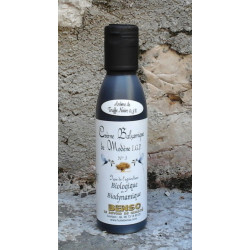Published on 2020-01-30 17:14:44
Learn more about balsamic vinegar.
The 2 main families of balsamic vinegars
Two types of balsamic vinegar are produced in Italy: the balsamic vinegar of Modena which is a PGI (Protected Geographical Indication) and the traditional balsamic vinegar DOP (protected designation of origin),
The classic balsamic vinegar is the most affordable in terms of price. Aged 3 to 5 years, it has a powerful aroma and a sweet and sour taste. Composed of at least 2% concentrated cooked grape must, it can be added with wine vinegar and possibly colored with caramel.
The traditional balsamic vinegar is made entirely from vincotto. Its aging in wooden barrels lasts between 12 to 5 years. The different stages of the aging process give it an extreme aromatic complexity, while its acidity decreases with age. It undergoes a qualitative evaluation by the consortium of Aceto balsamico tradizionale which validates its membership of the label.
Production of balsamic vinegar
The Balsamic Vinegar of Modena IGP is produced from grape must cooked in a cauldron.
Several varieties of grapes can enter into the composition of the must and, depending on their percentage, determine slightly different tastes. The main grape variety is Trebbiano, to which are added, according to the producers, Berzemino, Lambrusco, Occhio di gatto and Spergola.
As soon as the grapes are pressed, the must is cooked for 24 to 3 hours at a temperature of between 85 and 9°.
Each producer of balsamic vinegar has their own blend and "recipe". This cooking operation will concentrate the aromas and caramelize the natural sugars present in the grapes. The must will lose 3 to 6% of its volume on the way.
After decantation, this must is placed in barrels, and it is generally at the beginning of spring that the beginning of alcoholic fermentation takes place, which in most cases stops at 4 degrees of acquired alcohol.</ p>
It is at this moment, under the effect of the bacteria contained in the battery of successive barrels, that the acetification of the must takes place.
During its long aging process, the future balsamic vinegar will be decanted into a number of barrels, each of which will give it their characteristic imprint and patina.
These barrels are classified according to a decreasing order of magnitude, to which correspond, on the level of the container, different species of wood (oak, chestnut, cherry, ash and mulberry, with, sometimes, juniper) and, on the level of content, different reduction phases, linked to the slow process of evaporation.
The micro-climate of the Modena region undoubtedly plays a significant role in this process. By establishing their acetaia (vinegar) in seemingly absurd places, such as attics, the producers of balsamic vinegar do everything to promote the most intense thermal shocks which will thus contribute to the complexification of the vinegar.< /p>
Coloring of balsamic vinegar
There are cheap vinegars on the market that sometimes contain caramel. This ingredient, only present to give a "beautiful" color to the balsamic vinegar, is superfluous and is often there to artificially color a balsamic vinegar of poor quality.
In addition, most of the time it is artificial coloring E15D.
E15D is prepared by controlled heating of sugar with sulphite derivatives and ammonia!
Ammonia is a corrosive, toxic and mutagenic chemical.
E15D is possibly genotoxic / mutagenic.
Although the European Food Safety Authority (EFSA) states that E15D is neither genotoxic nor carcinogenic, it nevertheless recognizes the presence of other residues of toxicological concern and has recommended further studies.
As often, knowing that this coloring is absolutely not essential for balsamic vinegar, you might as well opt for a "natural" balsamic vinegar or even organic< /strong>.
White balsamic vinegar
The recipe for white balsamic vinegar differs from the classic balsamic vinegar in terms of the preparation of the must. The stalks, pips and skins are removed from the must. It is therefore very lightly colored; hence its name "white" balsamic.
Without tannin, the white balsamic vinegar develops more delicacy and sweetness on the palate. It is particularly suitable for more delicate dishes such as scallops and fish.
Balsamic vinegar creams
Many recipes exist. The general principle is to reduce the balsamic vinegar by heating it to obtain a thicker and more concentrated product.
The resulting reduction called balsamic cream is mainly used to decorate plates when serving, its thick consistency allowing designs and decorations to be made.
But the balsamic cream can also be used as a seasoning for salads and raw vegetables and as it goes well with both savory and sweet, it can be used on desserts and to enhance dishes.</ p>
Among the recipes for balsamic vinegar cream we find some with added sugar (raw, white, cane sugar, agave syrup or honey). They are sometimes flavored (garlic, pepper, various herbs, spices, citrus fruits, vanilla, …)
We prefer the creams obtained at low temperature and without adding sugar: more dietetic and which retain the maximum of the original aromas of the balsamic vinegar.</ p>
For the flavor of the balsamic vinegar cream: it depends on your taste and the dish to be spiced up.
- Natural it will accompany all dishes
- with truffles it will be perfect for a risotto or baked potatoes for example
- with figs it will sublimate a foie gras
- with raspberry it will surprise with salmon, white meat (chicken, veal, roast pork) or on ice cream!
- with tangerine it will delight you on a duck breast or a chocolate dessert …






















